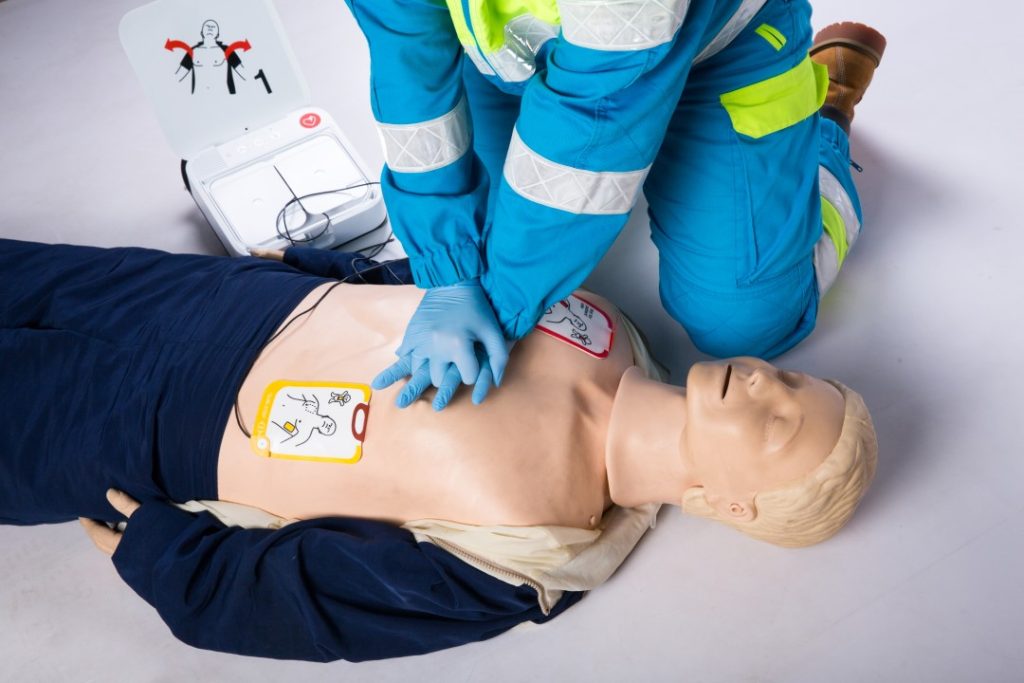Introduction
In the critical moments following cardiac arrest, every second counts. High-quality cardiopulmonary resuscitation (CPR) remains the cornerstone of resuscitation efforts, with chest compression fraction (CCF) emerging as a vital metric for survival outcomes. Automated CPR devices have revolutionized emergency response by consistently delivering the high chest compression fraction necessary for optimal patient outcomes. This advancement addresses one of the most significant challenges in manual CPR: maintaining effective compressions throughout the resuscitation process without interruption or fatigue.
Modern healthcare professionals recognize that maximizing chest compression fraction—the proportion of time during a cardiac arrest when compressions are being performed—significantly improves chances of survival. Automated CPR devices ensure this critical continuity by delivering precise, uninterrupted compressions regardless of provider fatigue, transport conditions, or procedural complexities. As emergency medicine continues to evolve, these devices represent a crucial advancement in maintaining the high chest compression fraction that can mean the difference between life and death.
Understanding Chest Compression Fraction
The Critical Importance of High Chest Compression Fraction
Chest compression fraction represents the percentage of time during cardiac arrest resuscitation when chest compressions are actively being delivered. Research has consistently demonstrated that higher CCF correlates strongly with improved survival rates and better neurological outcomes. The American Heart Association recommends maintaining a chest compression fraction of at least 80%, meaning compressions should be delivered for 80% or more of the total resuscitation time.
When chest compression fraction falls below optimal levels, coronary and cerebral perfusion pressures drop significantly. These pressures, which are built up through continuous compressions, are essential for delivering oxygen-rich blood to vital organs during cardiac arrest. Even brief interruptions can cause these pressures to collapse, requiring additional compressions to rebuild them, precious time that compromises patient outcomes.
Challenges in Maintaining High Chest Compression Fraction
Manual CPR, while effective when performed correctly, faces significant challenges in maintaining high chest compression fraction. Provider fatigue represents perhaps the most significant barrier, as the physical demands of delivering effective compressions lead to rapid decline in quality after just 1-2 minutes. This necessitates frequent provider switches, creating inevitable pauses that reduce overall CCF.
Additionally, the logistical challenges of CPR during patient movement and transport create substantial interruptions. Traditional manual CPR becomes particularly difficult during ambulance transport, elevator transfers, or movement through narrow corridors. Environmental factors and space limitations in these scenarios often force compression pauses, further compromising the vital high chest compression fraction necessary for optimal outcomes.
Automated CPR Devices: Technological Solution for High CCF
How Automated Devices Maximize Chest Compression Fraction
Automated CPR devices address the fundamental limitations of manual compressions through consistent, tireless operation. These devices maintain precisely calibrated compression depth, rate, and recoil—critical components of high-quality CPR—without variation over time. Unlike human providers, mechanical systems do not experience fatigue, emotional stress, or distraction, allowing them to deliver the high chest compression fraction required for optimal resuscitation.
Most modern automated CPR systems feature uninterrupted operation capabilities, maintaining compressions during patient movement, transport, and even during certain diagnostic procedures. This continuous operation significantly elevates chest compression fraction compared to manual techniques, which necessarily include pauses for provider switches, transport adjustments, and physical repositioning.
Types of Automated CPR Devices
Several categories of automated CPR devices have emerged, each utilizing different mechanisms to achieve a high chest compression fraction:
- Piston-Driven Devices: These systems use an electrically or pneumatically powered piston mechanism to deliver vertical compressions to the sternum. The compression depth and rate can be precisely controlled, ensuring consistent quality regardless of duration.
- Load-Distributing Band Devices: Rather than focusing force on the sternum alone, these systems utilize a circumferential band that compresses the entire chest. This design distributes the compression force more widely, potentially improving blood flow while maintaining a high chest compression fraction.
- Vest Inflation Systems: These specialized devices use rhythmic inflation of a vest surrounding the patient’s thorax to generate circumferential compression. The pneumatic operation allows for consistent compression quality that supports high chest compression fraction during extended resuscitation efforts.
Each system offers unique advantages, but all share the fundamental capability of maintaining the high chest compression fraction that research has identified as crucial for survival.
Clinical Evidence Supporting Automated CPR for High CCF
Research on Chest Compression Fraction Improvements
Multiple clinical studies have demonstrated the superiority of automated CPR devices in achieving and maintaining high chest compression fraction. A landmark study published in Resuscitation found that automated devices achieved average CCF of 91.5% compared to just 67.2% with manual CPR—a dramatic improvement that directly correlates with survival potential. This significant difference becomes even more pronounced during complex resuscitation scenarios involving transport or multiple interventions.
Research comparing pre-hospital resuscitation metrics shows that automated CPR systems consistently deliver more total compressions during equivalent timeframes. By eliminating the need for provider switches and maintaining compression during transport, these devices have demonstrated up to 25% more total compression time in typical emergency response scenarios, translating directly to higher chest compression fraction.
Impact on Patient Outcomes
The clinical consequences of improved chest compression fraction are substantial. Studies examining neurologically intact survival have found measurable improvements when automated devices maintain high CCF during resuscitation. The uninterrupted coronary and cerebral perfusion pressures sustained through continuous compressions appear to preserve vital organ function more effectively than the fluctuating pressures associated with manual CPR’s interruptions.
Particularly compelling evidence comes from challenging resuscitation environments. In scenarios involving extended transport times, limited personnel, or complex procedures like percutaneous coronary intervention during active CPR, automated devices have demonstrated superior outcomes by maintaining the high chest compression fraction that would be impossible to achieve manually.
Implementing Automated CPR Devices in Clinical Practice
Integration with Resuscitation Protocols
For maximum benefit, automated CPR devices must be seamlessly integrated into comprehensive resuscitation protocols. Rapid deployment is essential—modern devices are designed for quick application, typically requiring less than 20 seconds to position and activate. This speed minimizes interruptions to chest compressions during the transition from manual to mechanical CPR, preserving the high chest compression fraction that influences outcomes.
Effective implementation requires standardized training programs that emphasize both technical competence with the devices and understanding of their role in maintaining high CCF. Healthcare systems that have successfully integrated automated CPR report that regular simulation training helps providers develop the muscle memory necessary for rapid device deployment while minimizing compression interruptions.
Best Practices for Maintaining High Chest Compression Fraction
Even with automated devices, certain practices enhance chest compression fraction:
- Pre-positioning equipment: Having devices immediately available and prepared before they’re needed minimizes deployment time.
- Choreographed transitions: Well-practiced transitions from manual to mechanical compressions can reduce interruptions to mere seconds.
- Continuous monitoring: Many advanced systems now include real-time CCF monitoring, allowing teams to identify and address interruptions immediately.
- Strategic pause planning: When pauses are necessary (for rhythm analysis or defibrillation), they should be meticulously planned and executed with maximum efficiency.
These approaches, combined with automated devices’ inherent advantages, create the optimal conditions for achieving and maintaining the high chest compression fraction associated with positive outcomes.
Future Directions in Automated CPR Technology
Emerging Innovations for Higher Chest Compression Fraction
The next generation of automated CPR technology focuses on further improving chest compression fraction through several innovations:
- Integrated physiological feedback systems: Newer devices incorporate real-time measurements of end-tidal CO2, arterial pressure, and even tissue perfusion to optimize compression parameters dynamically.
- Seamless imaging compatibility: Advanced materials and design modifications are enabling CPR to continue uninterrupted during CT scanning and other imaging procedures.
- Artificial intelligence optimization: Machine learning algorithms are being developed to analyze compression effectiveness and adjust parameters in real-time for optimal perfusion.
These developments promise to further enhance the already significant advantages automated devices offer in maintaining high chest compression fraction during challenging resuscitations.
Research Priorities and Knowledge Gaps
Despite substantial progress, important questions remain regarding chest compression fraction optimization:
- Which patient subgroups benefit most from the higher CCF provided by automated devices?
- What is the optimal chest compression fraction for different cardiac arrest etiologies?
- How do various automated device mechanisms compare in terms of actual organ perfusion during high CCF operation?
Ongoing research addressing these questions will further refine our understanding of how best to implement automated CPR technology to maximize the benefits of high chest compression fraction.
Conclusion
The evidence strongly supports automated CPR devices as effective tools for achieving and maintaining the high chest compression fraction associated with improved survival and neurological outcomes. By eliminating provider fatigue, enabling continuous compressions during transport, and standardizing compression quality, these systems address the fundamental limitations of manual CPR in maintaining optimal chest compression fraction.
As resuscitation science continues to evolve, automated CPR devices represent a critical advancement in the effort to improve cardiac arrest outcomes. Their ability to deliver consistent, high-quality compressions with minimal interruptions directly addresses one of the most significant factors in resuscitation success: maintaining a high chest compression fraction throughout the entire resuscitation effort.
Take Action Today
Ensure your team is prepared with both the knowledge and tools needed for optimal resuscitation outcomes. CPR Memphis offers comprehensive training in both manual techniques and advanced automated CPR device operation. Our American Heart Association certified courses give healthcare professionals the confidence and competence to maximize chest compression fraction in any emergency scenario.
For the best CPR certification Memphis has to offer, contact CPR Memphis today. Our stress-free, hands-on approach makes learning effective and engaging. We also provide specialized BLS certification Memphis healthcare providers trust for emergency preparedness. Visit CPR Memphis to ensure your team has the skills to deliver the high-quality CPR that saves lives when every second counts.





